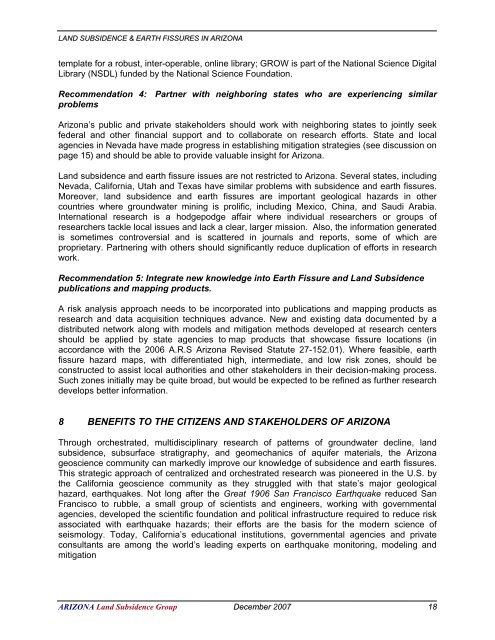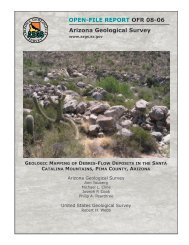land subsidence and earth fissures in arizona - The Arizona ...
land subsidence and earth fissures in arizona - The Arizona ...
land subsidence and earth fissures in arizona - The Arizona ...
Create successful ePaper yourself
Turn your PDF publications into a flip-book with our unique Google optimized e-Paper software.
LAND SUBSIDENCE & EARTH FISSURES IN ARIZONA<br />
template for a robust, <strong>in</strong>ter-operable, onl<strong>in</strong>e library; GROW is part of the National Science Digital<br />
Library (NSDL) funded by the National Science Foundation.<br />
Recommendation 4: Partner with neighbor<strong>in</strong>g states who are experienc<strong>in</strong>g similar<br />
problems<br />
<strong>Arizona</strong>’s public <strong>and</strong> private stakeholders should work with neighbor<strong>in</strong>g states to jo<strong>in</strong>tly seek<br />
federal <strong>and</strong> other f<strong>in</strong>ancial support <strong>and</strong> to collaborate on research efforts. State <strong>and</strong> local<br />
agencies <strong>in</strong> Nevada have made progress <strong>in</strong> establish<strong>in</strong>g mitigation strategies (see discussion on<br />
page 15) <strong>and</strong> should be able to provide valuable <strong>in</strong>sight for <strong>Arizona</strong>.<br />
L<strong>and</strong> <strong>subsidence</strong> <strong>and</strong> <strong>earth</strong> fissure issues are not restricted to <strong>Arizona</strong>. Several states, <strong>in</strong>clud<strong>in</strong>g<br />
Nevada, California, Utah <strong>and</strong> Texas have similar problems with <strong>subsidence</strong> <strong>and</strong> <strong>earth</strong> <strong>fissures</strong>.<br />
Moreover, <strong>l<strong>and</strong></strong> <strong>subsidence</strong> <strong>and</strong> <strong>earth</strong> <strong>fissures</strong> are important geological hazards <strong>in</strong> other<br />
countries where groundwater m<strong>in</strong><strong>in</strong>g is prolific, <strong>in</strong>clud<strong>in</strong>g Mexico, Ch<strong>in</strong>a, <strong>and</strong> Saudi Arabia.<br />
International research is a hodgepodge affair where <strong>in</strong>dividual researchers or groups of<br />
researchers tackle local issues <strong>and</strong> lack a clear, larger mission. Also, the <strong>in</strong>formation generated<br />
is sometimes controversial <strong>and</strong> is scattered <strong>in</strong> journals <strong>and</strong> reports, some of which are<br />
proprietary. Partner<strong>in</strong>g with others should significantly reduce duplication of efforts <strong>in</strong> research<br />
work.<br />
Recommendation 5: Integrate new knowledge <strong>in</strong>to Earth Fissure <strong>and</strong> L<strong>and</strong> Subsidence<br />
publications <strong>and</strong> mapp<strong>in</strong>g products.<br />
A risk analysis approach needs to be <strong>in</strong>corporated <strong>in</strong>to publications <strong>and</strong> mapp<strong>in</strong>g products as<br />
research <strong>and</strong> data acquisition techniques advance. New <strong>and</strong> exist<strong>in</strong>g data documented by a<br />
distributed network along with models <strong>and</strong> mitigation methods developed at research centers<br />
should be applied by state agencies to map products that showcase fissure locations (<strong>in</strong><br />
accordance with the 2006 A.R.S <strong>Arizona</strong> Revised Statute 27-152.01). Where feasible, <strong>earth</strong><br />
fissure hazard maps, with differentiated high, <strong>in</strong>termediate, <strong>and</strong> low risk zones, should be<br />
constructed to assist local authorities <strong>and</strong> other stakeholders <strong>in</strong> their decision-mak<strong>in</strong>g process.<br />
Such zones <strong>in</strong>itially may be quite broad, but would be expected to be ref<strong>in</strong>ed as further research<br />
develops better <strong>in</strong>formation.<br />
8 BENEFITS TO THE CITIZENS AND STAKEHOLDERS OF ARIZONA<br />
Through orchestrated, multidiscipl<strong>in</strong>ary research of patterns of groundwater decl<strong>in</strong>e, <strong>l<strong>and</strong></strong><br />
<strong>subsidence</strong>, subsurface stratigraphy, <strong>and</strong> geomechanics of aquifer materials, the <strong>Arizona</strong><br />
geoscience community can markedly improve our knowledge of <strong>subsidence</strong> <strong>and</strong> <strong>earth</strong> <strong>fissures</strong>.<br />
This strategic approach of centralized <strong>and</strong> orchestrated research was pioneered <strong>in</strong> the U.S. by<br />
the California geoscience community as they struggled with that state’s major geological<br />
hazard, <strong>earth</strong>quakes. Not long after the Great 1906 San Francisco Earthquake reduced San<br />
Francisco to rubble, a small group of scientists <strong>and</strong> eng<strong>in</strong>eers, work<strong>in</strong>g with governmental<br />
agencies, developed the scientific foundation <strong>and</strong> political <strong>in</strong>frastructure required to reduce risk<br />
associated with <strong>earth</strong>quake hazards; their efforts are the basis for the modern science of<br />
seismology. Today, California’s educational <strong>in</strong>stitutions, governmental agencies <strong>and</strong> private<br />
consultants are among the world’s lead<strong>in</strong>g experts on <strong>earth</strong>quake monitor<strong>in</strong>g, model<strong>in</strong>g <strong>and</strong><br />
mitigation<br />
ARIZONA L<strong>and</strong> Subsidence Group December 2007 18

















